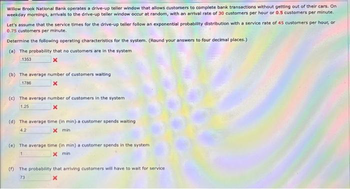
A First Course in Probability (10th Edition)
10th Edition
ISBN: 9780134753119
Author: Sheldon Ross
Publisher: PEARSON
expand_more
expand_more
format_list_bulleted
Question

Transcribed Image Text:Willow Brook National Bank operates a drive-up teller window that allows customers to complete bank transactions without getting out of their cars. On
weekday mornings, arrivals to the drive-up teller window occur at random, with an arrival rate of 30 customers per hour or 0.5 customers per minute.
Let's assume that the service times for the drive-up teller follow an exponential probability distribution with a service rate of 45 customers per hour, or
0.75 customers per minute.
Determine the following operating characteristics for the system. (Round your answers to four decimal places.)
(a) The probability that no customers are in the system
1353
(b) The average number of customers waiting
1786
(c) The average number of customers in the system
1.25
(d) The average time (in min) a customer spends waiting
4.2
X min
(e) The average time (in min) a customer spends in the system
x min
1
(f) The probability that arriving customers will have to wait for service
73
X
Expert Solution
This question has been solved!
Explore an expertly crafted, step-by-step solution for a thorough understanding of key concepts.
This is a popular solution
Step 1: Given information
VIEW Step 2: Calculate probability
VIEW Step 3: Calculate average number of customer waiting
VIEW Step 4: Calculate average number of customers in the system
VIEW Step 5: Calculate average time
VIEW Step 6: Calculate average time customers spend in the system
VIEW Step 7: Calculate probability
VIEW Solution
VIEW Trending nowThis is a popular solution!
Step by stepSolved in 8 steps with 15 images

Knowledge Booster
Similar questions
- In a video game, a specific attack succeeds at a rate of 18% and every try is independent. Determine the probability that the first attack lands on the 2nd or 6th try.arrow_forwardAssume that when adults with smartphones are randomly selected, 56% use them in meetings or classes. If 25 adult smartphone users are randomly selected, find the probability that exactly 20 of them use their smartphones in meetings or classes.arrow_forwardAutumn has purchased the insurance policy from an insurance company to cover the value of hers house in case if it gets destroyed due to a fire for the price of $1600 per year. Autumn's house is worth $370000 and the probability that fire destroys the house during the length of the policy is estimated to be 0.4%. Let XX be the insurance company's profit. Answer the following questions: 1. Create the probability distribution table for XX : XX outcome profit xx ,$ P(X=x)P(X=x) the house is destroyed the house survived 2. Use the probability distribution table to find the following: E[X]=μX=E[X]=μX= dollars. (Round the answer to 1 decimal place.) SD[X]=σX=SD[X]=σX= dollars. (Round the answer to 1 decimal place.)arrow_forward
- A certain disease has an incidence rate of 0.8%. If the false negative rate is 5% and the false positive rate is 1%, compute the probability that a person who tests positive actually has the disease.arrow_forwardAssume that when adults with smartphones are randomly selected, 35% use them in meetings or classes. If 9 adult smartphone users are randomly selected, find the probability that exactly 4 of them use their smartphones in meetings or classes.arrow_forwardIn a recent year 304 of the appoximately 300,000,000 people in the USA were struck by lightning.estimate the probability that a randomly selected person in the USA will be struck by lightning this yeararrow_forward
- While driving in the car with his family Jeffery likes to look out the window to find punch buggies. On average Jeffery see 3.85 punch buggies per hour. Assume seeing punch buggies follows a poisson process. A. Find the probability Jeffrey sees exactly 2 punch buggies in an hour. B. Find the probability Jeffrey sees more than 2 punch buggies in an hour.arrow_forwardIn a recent poll of voters, 20% were displeased with both candidates. If 3 people were picked at random. find the probability that at least one liked one of the candidates.arrow_forwardAssume that when adults with smartphones are randomly selected, 52% use them in meetings or classes. If 25 adult smartphone users are randomly selected, find the probability that exactly 19 of them use their smartphones in meetings or classes. The probability is. (Round to four decimal places as needed.)arrow_forward
- In a video game, a specific attack succeeds at a rate of 20% and every try is independent. Determine the probability that the first attack lands on the 3rd try.arrow_forwardaccording to the world bank, only 9% of the population of Uganda had access to electricity as of 2009. suppose we randomly sample 188 people in Uganda. let x= the number of people who have access to electricity. find the probability that at most 10 people in the sample have access to electricity. (round your answer to four decimal places.) find the probability that more than 25 people in the sample have access to electricity. (round your answer to four decimal places.)arrow_forwardAssume that when adults with smartphones are randomly selected, 57% use them in meetings or classes. If 30 adult smartphone users are randomly selected, find the probability that exactly 24 of them use their smartphones in meetings or classes.arrow_forward
arrow_back_ios
SEE MORE QUESTIONS
arrow_forward_ios
Recommended textbooks for you
 A First Course in Probability (10th Edition)ProbabilityISBN:9780134753119Author:Sheldon RossPublisher:PEARSON
A First Course in Probability (10th Edition)ProbabilityISBN:9780134753119Author:Sheldon RossPublisher:PEARSON

A First Course in Probability (10th Edition)
Probability
ISBN:9780134753119
Author:Sheldon Ross
Publisher:PEARSON
